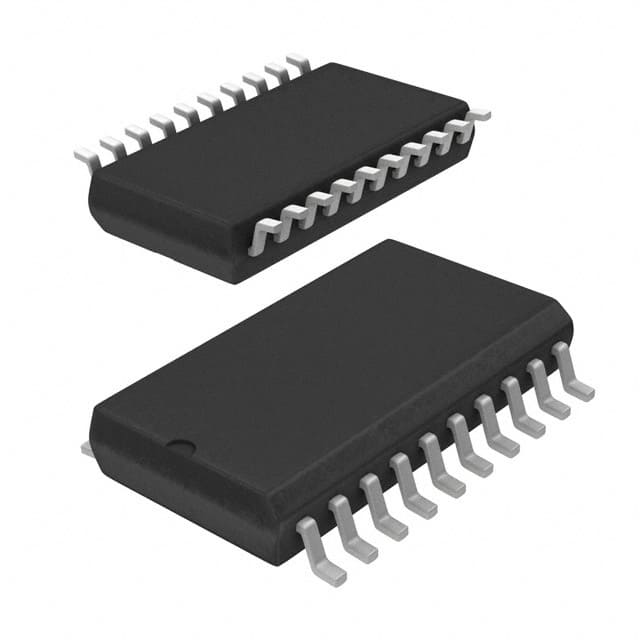Viz Specifikace pro podrobnosti o produktu.

Encyclopedia Entry: 74VHCT245ASJX
Product Overview
Category
The 74VHCT245ASJX belongs to the category of integrated circuits (ICs).
Use
This IC is commonly used for signal level shifting and voltage translation in digital systems.
Characteristics
- High-speed operation
- Low power consumption
- Wide operating voltage range
- Compatibility with TTL and CMOS logic levels
Package
The 74VHCT245ASJX is available in a small outline integrated circuit (SOIC) package.
Essence
The essence of this product lies in its ability to facilitate seamless communication between devices operating at different voltage levels.
Packaging/Quantity
The 74VHCT245ASJX is typically packaged in reels or tubes, with quantities varying depending on the supplier.
Specifications
- Supply Voltage Range: 2.0V to 5.5V
- Input Voltage Range: 0V to VCC
- Output Voltage Range: 0V to VCC
- Maximum Operating Frequency: 125 MHz
- Number of Channels: 8
- Input/Output Type: Tri-State
Detailed Pin Configuration
- A1 - Channel A Data Input
- A2 - Channel A Data Input
- GND - Ground
- A3 - Channel A Data Input
- A4 - Channel A Data Input
- A5 - Channel A Data Input
- A6 - Channel A Data Input
- VCC - Power Supply
- B1 - Channel B Data Input
- B2 - Channel B Data Input
- B3 - Channel B Data Input
- B4 - Channel B Data Input
- B5 - Channel B Data Input
- B6 - Channel B Data Input
- OE - Output Enable
- B7 - Channel B Data Input
Functional Features
- Bidirectional voltage level shifting
- Non-inverting logic translation
- High-speed data transfer
- Tri-state outputs for bus-oriented applications
- ESD protection on all inputs and outputs
Advantages and Disadvantages
Advantages
- Wide operating voltage range allows compatibility with various systems
- Low power consumption enhances energy efficiency
- High-speed operation enables rapid data transfer
- Tri-state outputs facilitate bus sharing in multi-device setups
Disadvantages
- Limited number of channels (8) may not be sufficient for complex systems requiring more connections
- Lack of built-in voltage regulation may require additional external components in certain applications
Working Principles
The 74VHCT245ASJX operates by receiving digital signals from one set of input pins (A1-A6) and translating them to a different voltage level, which is then outputted through the corresponding pins (B1-B7). The direction of data flow can be controlled using the Output Enable (OE) pin. When OE is high, the outputs are enabled, allowing data transmission. Conversely, when OE is low, the outputs are disabled, effectively isolating the input and output sides.
Detailed Application Field Plans
The 74VHCT245ASJX finds extensive use in various digital systems, including but not limited to: - Microcontrollers - Data communication interfaces - Memory modules - Industrial automation equipment - Automotive electronics
Detailed and Complete Alternative Models
- SN74LVC245A: Similar functionality with a lower operating voltage range (1.65V to 5.5V).
- MC74VHC245: Higher maximum operating frequency (200 MHz) with similar characteristics.
- CD74HCT245: Compatible with higher voltage levels (up to 6V) but with slower speed.
These alternative models offer similar voltage level shifting capabilities, but their specifications and characteristics may vary. It is important to consider the specific requirements of the application when selecting an alternative model.
Word count: 533 words
Seznam 10 běžných otázek a odpovědí souvisejících s aplikací 74VHCT245ASJX v technických řešeních
Sure! Here are 10 common questions and answers related to the application of 74VHCT245ASJX in technical solutions:
Q: What is the 74VHCT245ASJX? A: The 74VHCT245ASJX is a high-speed octal bus transceiver with 3-state outputs, commonly used for level shifting and signal buffering.
Q: What is the operating voltage range of the 74VHCT245ASJX? A: The 74VHCT245ASJX operates within a voltage range of 4.5V to 5.5V.
Q: How many channels does the 74VHCT245ASJX have? A: The 74VHCT245ASJX has 8 bidirectional channels, allowing data transmission in both directions.
Q: What is the maximum data transfer rate supported by the 74VHCT245ASJX? A: The 74VHCT245ASJX supports a maximum data transfer rate of 200 MHz.
Q: Can the 74VHCT245ASJX be used for voltage level shifting between different logic families? A: Yes, the 74VHCT245ASJX is compatible with various logic families, making it suitable for voltage level shifting applications.
Q: Does the 74VHCT245ASJX have built-in protection features? A: No, the 74VHCT245ASJX does not have built-in protection features. Additional external protection may be required depending on the application.
Q: What is the output drive capability of the 74VHCT245ASJX? A: The 74VHCT245ASJX has a typical output drive capability of ±8 mA.
Q: Can the 74VHCT245ASJX be used in bidirectional data communication systems? A: Yes, the 74VHCT245ASJX is designed for bidirectional data transmission and can be used in bidirectional communication systems.
Q: What is the power supply current consumption of the 74VHCT245ASJX? A: The power supply current consumption of the 74VHCT245ASJX varies depending on the operating conditions but typically ranges from 10 mA to 20 mA.
Q: Are there any recommended layout guidelines for using the 74VHCT245ASJX? A: Yes, it is recommended to follow the manufacturer's layout guidelines, including proper decoupling capacitors placement and minimizing trace lengths to reduce noise and ensure optimal performance.
Please note that these answers are general and may vary based on specific datasheet specifications and application requirements.

